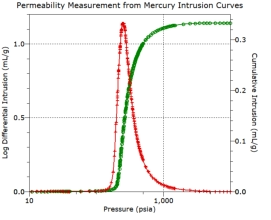Tel: 01763 262333
Permeability and Tortuosity Measurement
Sample
permeability
and
tortuosity
measurement
is
offered
as
an
extension
to
our
standard
mercury
porosimetry
analysis
options.
The
analysis
also
includes
pore
size,
pore
volume
and
pore
area
characterisation
in
the
pore
size
range
3.5
nm
to
650
µm
as
well
as
bulk
density,
skeletal
density
and
absolute
(%
volume)
porosity.
Porosity
and
permeability
are,
therefore,
determined
in
a
single
analysis
which
provides
a
wealth
of
information in a short time-frame.
Permeability
is
a
measure
of
fluid
or
gas
flow
through
a
porous
solid
sample.
It
is,
therefore,
of
considerable
interest
in
applications
where
a
solid
material
interacts
with
a
liquid
or
gas.
Permeability
measurement
from
mercury
intrusion
analysis
was
originally
developed
with
regard
to
geological samples, but it has since found significant application to a wide variety of sample types and sectors.
Pore
tortuosity,
obtained
from
characteristics
of
pore
size,
pore
volume,
pore
area
and
permeability
is
a
measure
of
the
tortuous
pathway
of
pores
through
a
sample:
essentially
a
representation
of
how
direct
the
pore
pathway
is
as
it
passes
through
a
sample.
This
can
be
particularly
useful
when comparing samples.
Key Applications
Investigation of relationship between solid and fluid media
Passage and retention capabilities of fluids and gases
Geological and geo-technical testing
Petrology and Hydrology
Battery electrodes: electrolyte flow & active site accessibility
Battery separators: electrolyte flow properties
Catalyst testing: accessibility to active sites
Pharmaceuticals: dissolution and disintegration properties
Filter media: flow and retention properties
Membranes and papers: flow throughout properties
Ceramics: flow throughput and capacity properties

The
calculation
of
permeability
requires
the
threshold
pressure
of
mercury
intrusion,
bulk
sample
density
and
absolute
sample
density.
Density
values
are
calculated
from
the
accompanying
mercury
intrusion
analysis
whilst
determination
of
threshold
pressure
from
the
mercury
intrusion
curve
requires
an
abundance
of
data
measurement
points.
Our
in-house
data
reduction
protocols
ensure
that
the
most
appropriate
values
are
selected
and
applied
to
provide
the
most
accurate
permeability
of
each
specific
sample
analysed.
Pore
tortuosity
requires
sample
permeability
and additionally a measure of pore area, which can also be applied directly from the accompanying mercury intrusion data.
Analytical Options and Highlights
Measurement of sample permeability and tortuosity
Assessment of fluid & gas flow characteristics through a sample
Assessment of pore pathway through a sample
Additional characterisation of sample porosity
Pore volume
Pore size distribution
Pore Area
Calculation of bulk and skeletal density
Calculation of absolute (% volume) porosity
Option for additional mercury extrusion analysis
Graphical and numerical data reports
At
MCA
Services
we
have
decades
of
experience
in
the
analysis
and
characterisation
of
materials
and
are
always
happy
to
discuss
specific
samples
and
applications.
The
flexibility
of
our
analytical
options
combined
with
our
expertise
ensures
that
the
most
appropriate
analytical
test,
or
combination
of
tests,
are
selected
for
your
particular
sample,
application
and
requirements.
We
also
provide
assistance
with
the
interpretation
of results and more information about these analytical options and the background operation and theory can be found on our YouTube channel.
Permeability and Tortuosity Measurement
Sample
permeability
and
tortuosity
measurement
is
offered
as
an
extension
to
our
standard
mercury
porosimetry
analysis
options.
The
analysis
also
includes
pore
size,
pore
volume
and
pore
area
characterisation
in
the
pore
size
range
3.5
nm
to
650
µm
as
well
as
bulk
density,
skeletal
density
and
absolute
(%
volume)
porosity.
Porosity
and
permeability
are,
therefore,
determined
in
a
single
analysis
which
provides
a
wealth
of
information
in
a
short
time-frame.
Permeability
is
a
measure
of
fluid
or
gas
flow
through
a
porous
solid
sample.
It
is,
therefore,
of
considerable
interest
in
applications
where
a
solid
material
interacts
with
a
liquid
or
gas.
Permeability
measurement
from
mercury
intrusion
analysis
was
originally
developed
with
regard
to
geological
samples,
but
it
has
since
found
significant
application
to
a
wide
variety
of
sample
types and sectors.
Pore
tortuosity,
obtained
from
characteristics
of
pore
size,
pore
volume,
pore
area
and
permeability
is
a
measure
of
the
tortuous
pathway
of
pores
through
a
sample:
essentially
a
representation
of
how
direct
the
pore
pathway
is
as
it
passes
through
a
sample.
This can be particularly useful when comparing samples.
Key Applications
Investigation of relationship between solid and fluid media
Passage and retention capabilities of fluids and gases
Geological and geo-technical testing
Petrology and Hydrology
Battery electrodes: electrolyte flow
Battery Electrodes: active site accessibility
Battery separators: electrolyte flow properties
Catalyst testing: accessibility to active sites
Pharmaceuticals: dissolution and disintegration properties
Filter media: flow and retention properties
Membranes and papers: flow throughout properties
Ceramics:
flow throughput and capacity properties

The
calculation
of
permeability
requires
the
threshold
pressure
of
mercury
intrusion,
bulk
sample
density
and
absolute
sample
density.
Density
values
are
calculated
from
the
accompanying
mercury
intrusion
analysis
whilst
determination
of
threshold
pressure
from
the
mercury
intrusion
curve
requires
an
abundance
of
data
measurement
points.
Our
in-house
data
reduction
protocols
ensure
that
the
most
appropriate
values
are
selected
and
applied
to
provide
the
most
accurate
permeability
of
each
specific
sample
analysed.
Pore
tortuosity
requires
sample
permeability
and
additionally
a
measure
of
pore
area,
which
can
also
be
applied
directly
from
the
accompanying
mercury
intrusion
data.
Analytical Options and Highlights
Measurement of sample permeability and tortuosity
Fluid & gas flow characteristics through a sample
Assessment of pore pathway through a sample
Additional characterisation of sample porosity
Pore volume
Pore size distribution
Pore Area
Calculation of bulk and skeletal density
Calculation of absolute (% volume) porosity
Option for additional mercury extrusion analysis
Grap
hical and numerical data reports

At
MCA
Services
we
have
decades
of
experience
in
the
analysis
and
characterisation
of
materials
and
are
always
happy
to
discuss
specific
samples
and
applications.
The
flexibility
of
our
analytical
options
combined
with
our
expertise
ensures
that
the
most
appropriate
analytical
test,
or
combination
of
tests,
are
selected
for
your
particular
sample,
application
and
requirements.
We
also
provide
assistance
with
the
interpretation
of
results
and
more
information
about
these
analytical
options
and
the
background
operation and theory can be found on our YouTube channel.

















